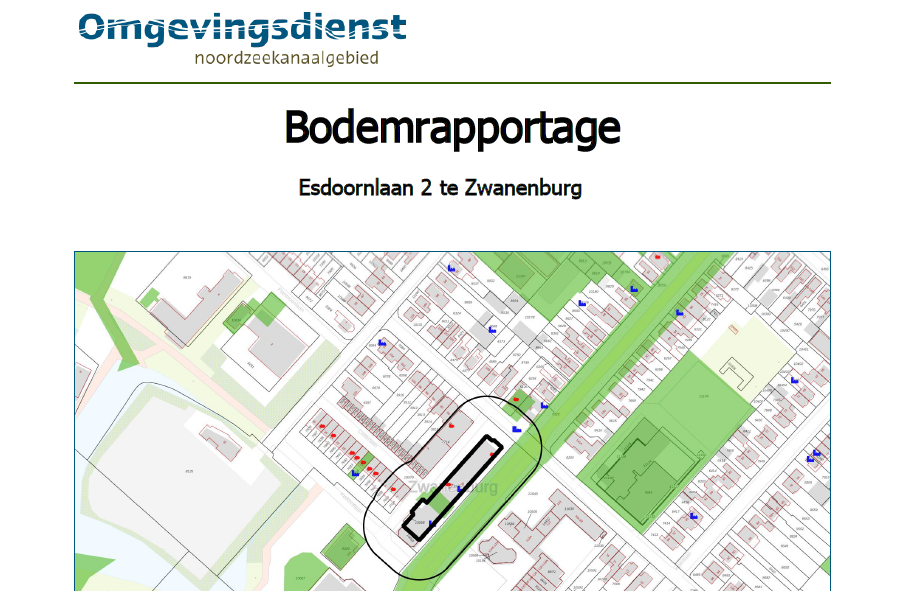A soil report is also called an environmental report. You are going to buy a house or a plot of land and you have received a soil report or environmental report. How on earth are you supposed to read that report and what can you do with it?
First of all: we have to deal with these kinds of reports on a daily basis and we will get straight to the point: it is an absolute horror to understand what they contain. Even environmentalists think so. Anyway. Let’s simply explain to you what you can do with it and how to read it. It is important to tire yourself first with a bit of general theory, so that you understand it better.
Where do soil reports come from?
If work is going to take place somewhere in the Netherlands, it is often mandatory to have an exploratory soil investigation carried out at the site of the work. For this type of work, think of new construction, major renovations, work on the road(s) or if there are changes to the zoning plan somewhere.
A specialized company in soil investigation will then be sent to carry out an exploratory investigation into the soil on location. What and in what way this company works depends on the nature of the situation and is subsequently bound by fixed NEN certified guidelines (NEN5740).
The research company therefore conducts an exploratory investigation and prepares a research report. This goes to the client (= applicant for the work). The client of the investigation then submits this investigation report again to the ‘competent authority’. By competent authority, we mean the government agency responsible for granting work approval. This can be the municipality or the province.
Just about every report that is made for research, determination, remediation, notification or reporting of a soil is centrally recorded by an environmental service. An environmental service is a government agency that is involved in the granting of permits, supervision and enforcement in the field of environmental matters. There are approximately 30 environmental services in the Netherlands.
They manage a huge digital file with all this research and factual soil information per location. If you want to know what is known about soil information about a certain location in the Netherlands, you can request a soil report (also known as ‘environmental report’) from the responsible environmental service. This often costs about €25. You can see an example of such an environmental report here.
But what exactly does an environmental report say?
The environmental report shows all known data within a radius of (often) 25 meters around the address you have requested. There is almost always information known within a radius of 25 meters around your house. Among other things, this report looks at:
-Do I know whether groundwater in that area is polluted or could be polluted?
– Are there old oil tanks (HBO tanks) in this area and if so, where, and what happened to them?
-What soil investigation reports have taken place in the area and what do they report?
-If there is pollution, which values have been measured and does this fall within acceptabe ranges or can the measured pollution value really be called serious/worrying?
-Are there any remediation orders or other orders under the Soil Protection Act, and if so, where and what is their status?
The structure of a soil report
The soil report therefore looks within a radius of 25 meters around the plot in question at all known reports, contaminations, historical activities (for example, there used to be a gas station here), remediation, etc etc.
The report always mentions something about HBO tanks. These are house heating oil tanks. Are these located here and if so where? The report then reports from top to bottom (often) in tabular form the determined measurements that have been taken. It could essentially look like this:
-Location: Zijlweg 64 Haarlem
-Type: Exploratory soil investigation
-Reason: Application for building permit
-Report number: 1234
-Report date: 01-02-2019 (february 1st, 2019)
-Contamination assessment: Serious, not urgent
-Conclusion: the results of the research are reported here (which often really doesn’t make you any wiser)
-With a bit of luck, below this, are references or hyperlinks to the research reports.
What should you pay attention to in a soil report?
Below we are going to flood you with information about how you can best understand these very unclear reports and what you just have to pay attention to soberly (also apart from the report) with a view to the soil quality when buying a plot of land or a house. . Note: if you get stuck or don’t feel like delving into this now, scroll all the way down. Here we answer in the last 2 questions what you can do if you need help.
The house heating oil tank
In the past, many houses were fired with domestic heating oil (HBO). This oil was stored in special underground storage tanks in the ground. If oil gets into the bottom due to damage in the tank, it will spread like pancake batter. A little bit of oil can pollute a huge area of soil and worse, the oil easily ends up in groundwater, which means it can pollute a much larger area.
Until 1998, old oil tanks could be cleaned and filled with sand by special certified companies. A KIWI certificate was then issued as proof of a sufficiently sanitized tank.
However, there are still HBO tanks that have not yet been remediated. These may no longer be cleaned and filled with sand, but must be removed. An investigation is also required into fuel products in the soil and groundwater. The costs for this can be quite high.
To make matters worse, not all old HBO tanks are known. It is possible that you buy a house with such a tank in the ground, without it being known anywhere.
By the way: one of the causes of a tank leak is the way in which it used to be measured how much oil was left in the tank. They went in with a dipstick and hit the bottom with it to hear how full the tank was. As a result, the spot where the dipstick has been hitting the bottom for years could have weakened it and eventually this bottom started to leak.
Recognizing and deciphering an oil tank from a soil report:

Above you can read part of a soil report stating that there is an oil tank. What you need to know is whether this oil tank has been cleaned and filled with sand by a certified company, or whether it has been removed. In the example above you can see that there was a tank but it has been neatly removed. Download THIS KIWA certificate via the link in the soil report. You now know that the oil tank problem has been solved properly and by a certified company.
What you don’t know yet is whether the ground is clean. Therefore, take a good look at the soil report to see whether oils or other fuel products have been measured and also where. If this is the case, it may be wise to remediate the soil after all, to prevent the oil/contamination from spreading to the neighbors. You are liable for the damage that the neighbor will suffer from this. This can really add up.
Asbestos – what should you keep in mind?
Forget the soil report for a moment. First, take your thoughts back to the plot or house you are working on. Have you seen asbestos roofs? In houses we still see this a lot on sheds. In the countryside you will encounter it a lot on farms (see also photo below). Here’s what you need to know about asbestos roofs versus soil quality. After an asbestos roof is about 20 years old, the fibers start to come loose and wash away with the rainwater. If that rainwater is neatly drained through a gutter that is connected to a rainwater drain, then there is little to worry about. However, if there is a ‘drip zone’ (water falls from the roof directly onto the ground), the asbestos fibers will reach the ground around your house. Hopefully there is paving around your house. This pavement still keeps out the asbestos fibers. If there is no pavement or if the rainwater washes away somewhere without pavement, the asbestos fibers can end up in the soil. It is also important to know that in dry weather the fibers can be blown away and eventually be inhaled. If you are going to buy a house where, for example, there is an asbestos roof on top of a shed, from which the rainwater washes directly into the ground, keep in mind that the ground can be contaminated up to approximately 1 meter from the facade. The chance is 80-90% that there is contamination with asbestos if there is a ‘drip zone’ (rainwater falls directly on the ground).
The soil report is not clairvoyant. If no measurements have been taken, it does not mean that there is no asbestos contamination. This can be caused by asbestos roofs, but also by rubble containing asbestos or mixtures containing asbestos in the soil. Asbestos found means: always remediate. The house or plot you buy may therefore appear clean, but it does not mean that you do not run great risks. If you want to be sure: have an exploratory soil investigation carried out (costs approximately €1000).
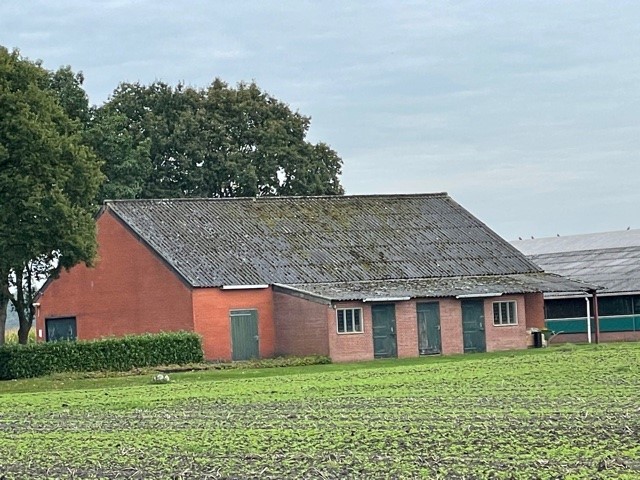
PCBs (Polychloorbifenyl)
You’re not going to be happy about this at all. Asbestos corrugated sheet roofs produced in the early 1970s often have a protective coating applied: PCBs. This is pure poison and it is released by erosion (wind, rain, etc.). The scary thing is that we don’t know everything about this stuff yet and it is estimated that it is in 20% of the asbestos roofs in the Netherlands. It is not easy to recognize and not much is known about the exact consequential damage. When the PCBs come loose, they wash away with the rainwater. If the rainwater is not drained through gutters, but drips directly onto the ground, the PCBs also end up in the ground. The good news is that crops hardly seem to absorb this. The bad news is that foraging animals (such as chickens) do absorb it. This threatens food safety. This pollution can reach up to about 3 meters from the facade.
remediation
Remediation can be done roughly in 2 ways: the contaminated soil is excavated and removed or the soil is cleaned on site. Remediation is generally a very expensive project. It often costs several tens of thousands of euros. In many cases, the budgeted costs are exceeded each time.
Sometimes it can also work out. Excavation or cleaning may not be necessary, but covering the contaminated soil with, for example, paving or a ‘living layer’ (soil) is sufficient. It is true that the pollution is still in the ground. A cadastral note will then be placed on the plot. You must then realize that this may deter future potential buyers or want to see the budgeted remediation costs for cleaning/excavation deducted from the purchase price.
Anyway, this is the reason that you really want to know in advance whether you are not buying a house with contaminated soil. You as the owner are always responsible for having a remediation carried out correctly and for paying all costs. If there is pollution on your land, for example due to a leaking oil tank, and if that pollution spreads out to the neighbor’s plot, you can also be held responsible through neighbor law for reimbursing all your neighbors remediation costs. Therefore, always take soil information and soil research very seriously!
Read carefully the conclusions of each part
See the observation and conclusion below:
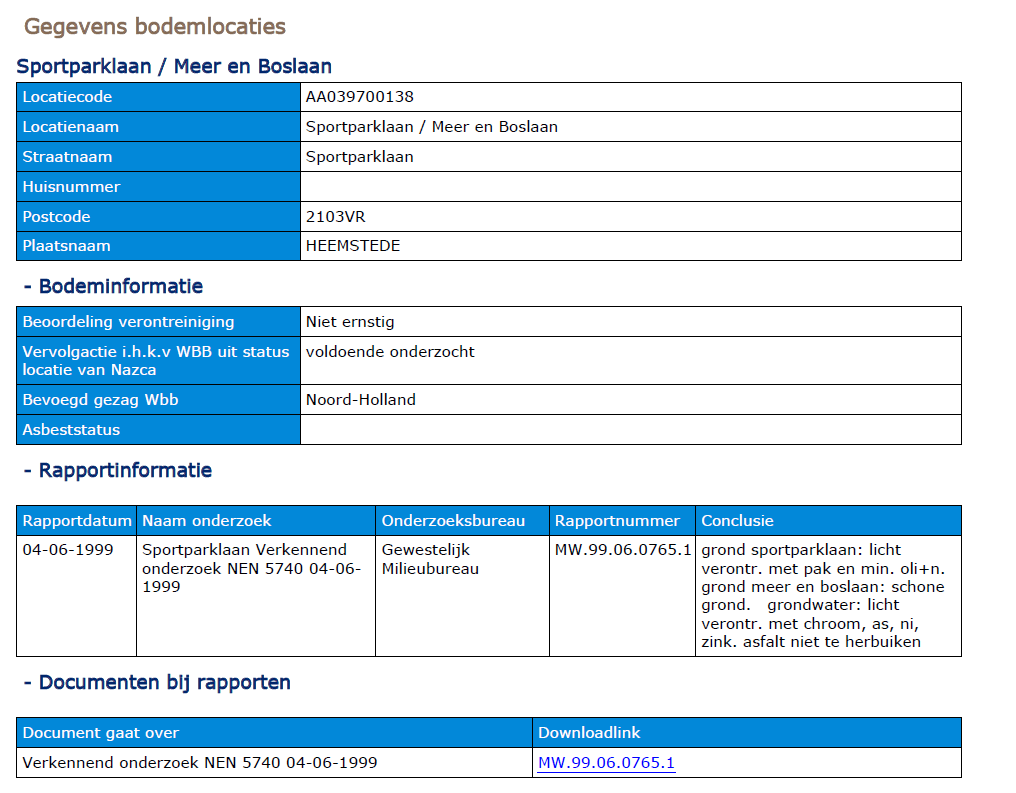
Slight contamination has therefore been established here in an exploratory study. This is rated ‘not serious’. The soil is contaminated with certain metals. These are location-bound and therefore remain where they are. However, mineral oils have also been measured, and these are NOT location-bound, they are ‘mobile’. They therefore spread out easily and also easily end up in the groundwater. It is therefore good to continue reading this exploratory study (via the download link in the report) to find out exactly what’s going on.
Pay attention to the intervention value and the follow-up actions
See the report below at the red arrow.
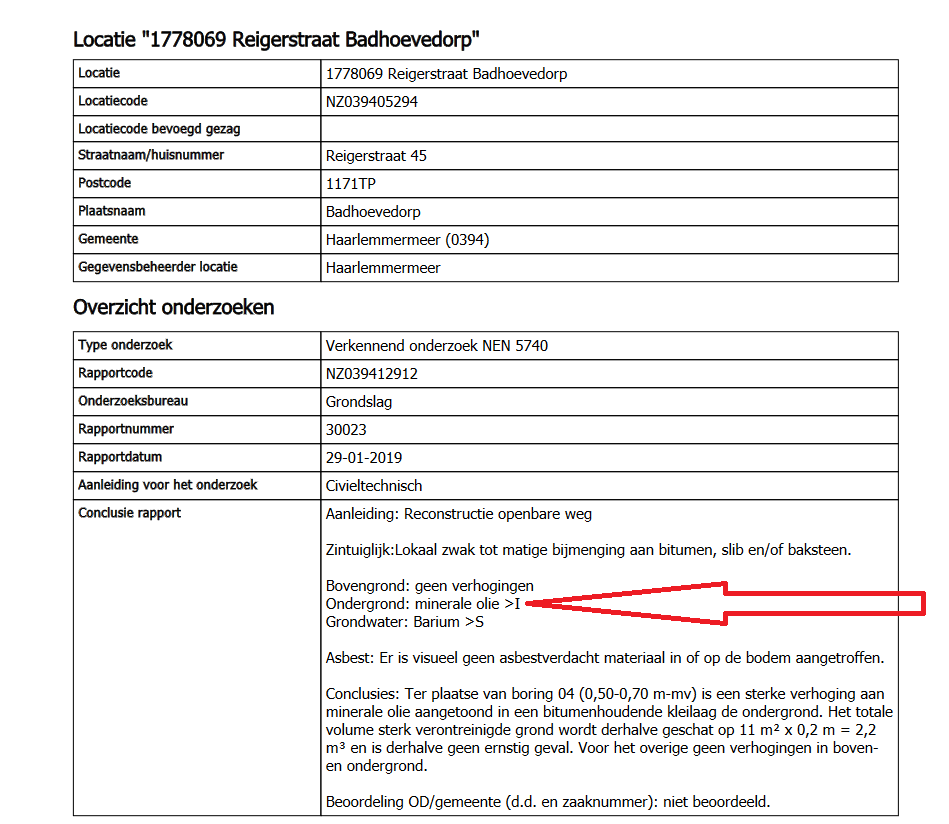
Here it says Substrate: mineral oil > I. The I stands for ‘Intervention value’. Greater than the intervention value (as in this example) simply means ‘contaminated’. Here you can read further in the conclusion that it is not given the status ‘serious’. This is because it is estimated that only 2.2m3 of soil is polluted. You are only obliged to remediate if more than 25m3 of soil is contaminated. What we do read here is that the soil is actually contaminated. If we read further, we see that the case is still waiting for assessment by the municipality and that nothing has been decided/assessed yet. With this plot it would therefore be wise to first contact the municipality and ask about the status of their decision-making about the pollution. If they think that remediation is necessary, then buying this house can turn out to be very expensive.
Where is the contamination and is it mobile or immobile?
Very often you read something in a soil report that simply does not make you any wiser. An example can be found below. Take a look and then we’ll explain how to read this and what to pay attention to.
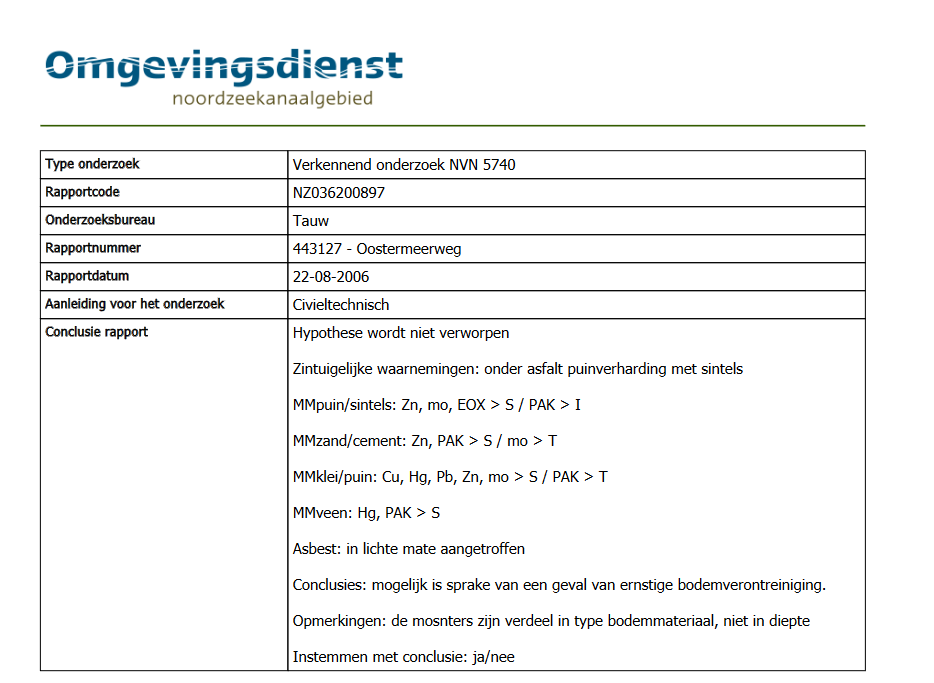
You read that the PAHs (polycyclic aromatic hydrocarbons) measured in the rubble/cinders are higher than the intervention value. Ok, so higher than the intervention value (> I) is not good. That means contaminated. But with what is it contaminated? PAHs is just a collective term for hundreds of chemical compounds of hydrogen and carbon. Simply put: they are combustion residues such as coals. Some are quite harmless and others are very carcinogenic. The conclusion states that there is ‘possibly serious soil contamination’. This research dates back to 2006. Furthermore, no follow-up studies or other information can be found in this soil report. This is it and this is where the information ends. You can read below how to deal with this.
First you answer the question: what is the location of the measured contamination? Is this in the backyard of a house you are about to buy? Then this is a big risk and you should definitely have further research done. In this case it concerned pollution along or under a busy main road that was further away. The next question you have to ask yourself is: can this pollution move through the ground and end up in my (new) backyard?
A quick internet search shows that PAHs are virtually immobile. So they can hardly or not at all move via the ground. In this case, it can turn out quite harmless for the plot further away that you have or want to buy. Of course it is always good and advisable to have an exploratory investigation carried out yourself on the plot that you have or that you want to buy in order to exclude as much risks as possible.
Make sure your alarm bells are on
If you have a soil report that is full of old and already remediated contaminants in the immediate vicinity of the home you are investigating, then alarm bells should ring for you. There may not be anything known on paper about pollution on your land, but if the ground of a large part of the neighbors was previously polluted, there is a very real chance that something could be wrong with your house, too. but it has simply never been researched before. If you are going to buy such a house, try to buy it under the condition of conducting an exploratory soil investigation. Then take into account that if it turns out that the ground is seriously polluted, you can get out of the bargain.
Increment layers
Be mindful of increments. In the past, soil has been applied at raising layers to build houses on. In the past, this was often applied to contaminated soil. You see that a lot in Gouda.
Request research reports
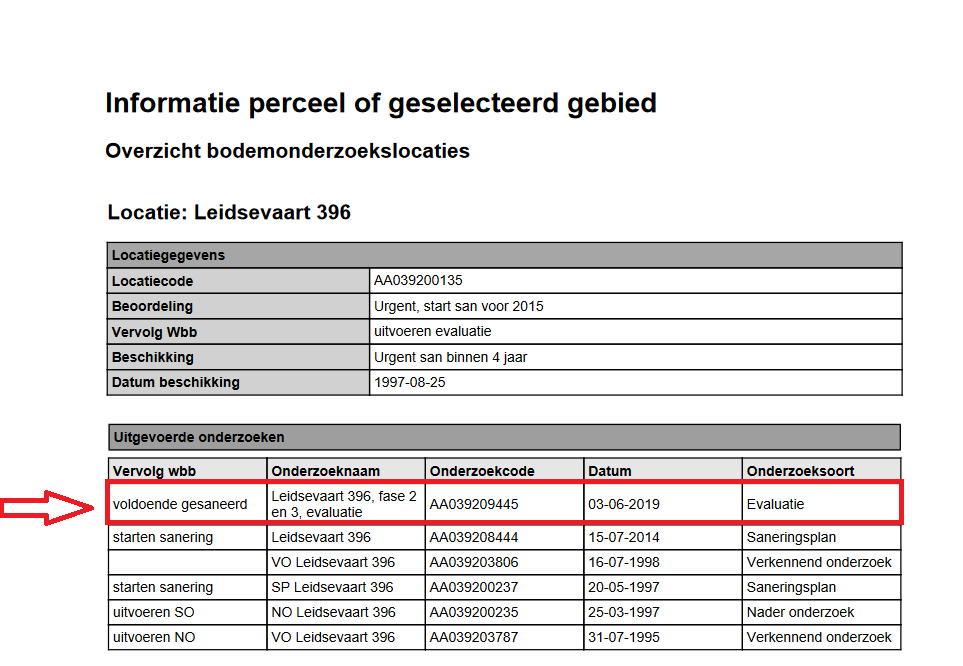
If you are reading this you will see that a cleanup has been carried out quite recently. There has also been an evaluation. But what does this say? Has the remediation been completely successful and that’s it?
If you are going to invest somewhere or buy a house where you come across this in the soil report, make sure you dig further and request the last known report. In this case, that’s the evaluation. The information from the other reports is probably also neatly listed in the last report. The last report is therefore usually sufficient. Note: the municipality will probably charge you fees for this.
What do these abbreviations or terms mean?
Background value = the quality of the soil (soil) that occurs there ‘naturally’. So what can be considered ‘normal’. This uses the environmental service as a reference value.
AP04 = batch inspection
BIS = Soil Information System (bodeminformatiesysteem)
BKK = Soil Quality Map (bodemkwaliteitskaart)
BKK = Soil Quality Map (Bodemkwaliteitskaart)
BOOT= Decision Storage Underground Tanks (Besluit Opslag Ondergrondse Tanks). This is a commonly used research strategy
BUS report = report that you are obliged to do if you want to remediate or carry out work in the soil that is seriously polluted. BUS = Decision Uniforma Remediation (Besluit Uniforma Saneringen).
EUT = Seriousness And Urgency (ernst en urgentie)
HO = Historical Research (Historisch Onderzoek)
HBB = Historical Soil File (Historisch Bodem Bestand)
I = Intervention value (Interventiewaarde) Contamination higher than the intervention value is wrong. If that is more than 25m3 of soil or more than 100m3 of groundwater, remediation is required.
Immobile: A contaminant in the soil that does not spread. The contamination therefore remains in place and does not go into the groundwater or the soil air. Examples are heavy metals and PAK’s (= PAH (polycyclic aromatic hydrocarbons – carbon particles)).
Mobile: A contamination in the soil that does spread. The contamination therefore does not stay in place and moves through the soil, spreads to the groundwater or to the soil air. Examples are petrol products or substances with chlorine.
NO = further investigation! (Nader Onderzoek)
OO = exploratory study (Oriënterend Onderzoek)
PAK = PAH = Polycyclic Aromatic Hydrocarbons. This is a collective name for chemical compounds of hydrogen and carbon. Examples: are Naphthalene, Biphenyl, Anthracene, Phenanthrene, Phenalene, Tetracene and Chrysene
S = Target value (this is what we consider ‘normal’)
SE = Remediation Evaluation (Saneringsevaluatie)
SO = Remediation Study (Saneringsonderzoek)
SP = Remediation Plan (Saneringsplan)
T = Intermediate value: half of the intervention value. Contamination higher than the intermediate value often means that further research is required into the measured contamination.
VO = Exploratory Research (Verkennend Onderzoek)
Wbb = Soil Protection Act (Wet Bodembescherming)
Other:
<= AW No elevated levels measured. In other words, the soil is clean.
> AW Slightly contaminated, greater than the nationally standardized Target Value “completely clean”
(S value). No further investigation is necessary.
> T Moderately polluted, greater than the nationally standard Intermediate Value (T-value). Often further investigation is necessary.
> I Heavily contaminated. If more than 25m3 of soil is contaminated or more than 100m3 of groundwater is contaminated, then it is mandatory to remediate.
What is an NSX score?
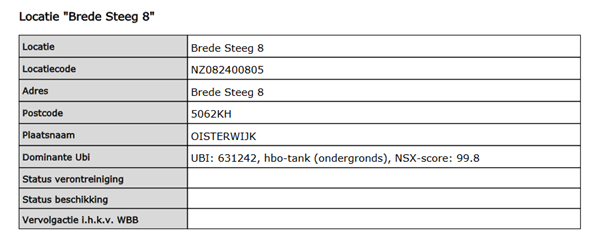
The NSX score can be used to estimate how soil-threatening the mentioned licensed activity is. This score ranges from 0 to 1000. A score of 0 means that the activity does not threaten the soil. A score of 1000 means that the activity is (to a large extent) soil threatening. A listing with a high score does not necessarily mean that soil contamination is actually present on the plot. Soil research will have to prove this.
What is UBI?
See also the image above. This means: Uniform Source Format (Uniforme Bronindeling). Simply put: it is a code that you can find in an UBI codebook that stands for a certain form of threat in the soil. So you can see in the image above: UBI 631242. According to the UBI code book a HBO tank (oil tank).
What is: Indicative Examination?
Indicative examination means that you do not fully meet the standard.
Normally you perform an exploratory soil investigation. For example, the standard prescribes: If your location is smaller than 500m2, and the strategy is ‘suspicious’, you must make 3 wells of a 0.5 meter, 1 well of 2 meters and place 1 monitoring well. It has now been decided not to investigate this according to the standard, but often to do a lighter, more simple investigation. So pay close attention to indicative research that this does not provide a complete and good picture.
The soil report shows nothing, is this a guarantee and if not, what can I do?
Do you have an environmental report and does your house come out completely ‘clean’? Note: This does not mean that the ground is clean. There may still very well be contamination, but that is not yet known. If you really want to be sure, you can ask an environmental engineering firm to do an exploratory soil test. The costs for this are approximately: €1000,-. Of course we understand that this is not always possible. But that is why it is also important to read and understand a soil report properly. If you are not sure what to do and having a soil investigation carried out is not an option, you could of course ask such an environmental consultancy if they would like to help you based on a ‘desk research’. This means that they will analyze the soil report and all relevant studies to which reference is made or which can be requested, after which they can provide you with specific advice about the risks.
You come across risks in the soil report, what can you do?
Again, basically the same advice applies here as the question above. Contact an environmental consulting firm and ask if they can help you. If you can get the opportunity (for example from the selling party) to have an exploratory soil investigation done, this is always the best and safest. But often that opportunity is not there. That is why you can also ask the consultancy if they can help you remotely by remotely analyzing all available soil information and giving you advice about the risks you run. How do you find an environmental consultancy? Just type in Google + the place where you live or we can help you find 1 of the environmental consulting and research firms we work with without obligation. For that, click here.

